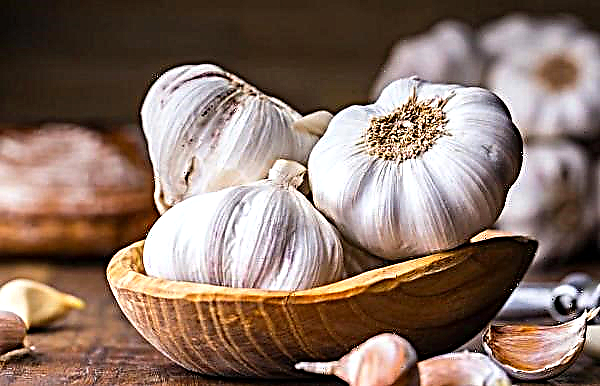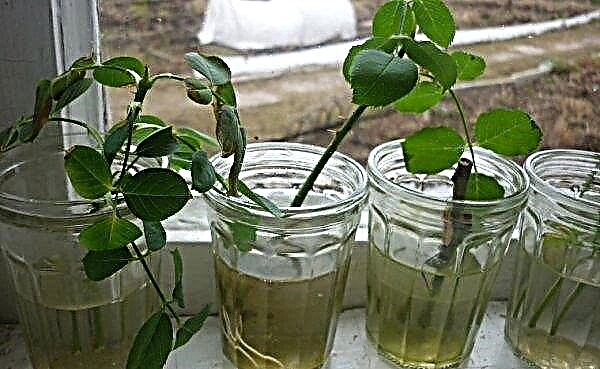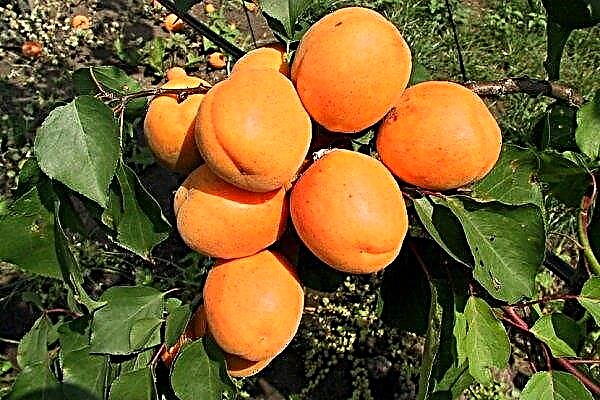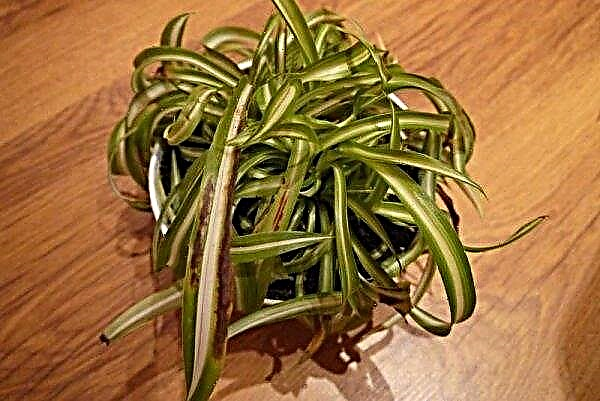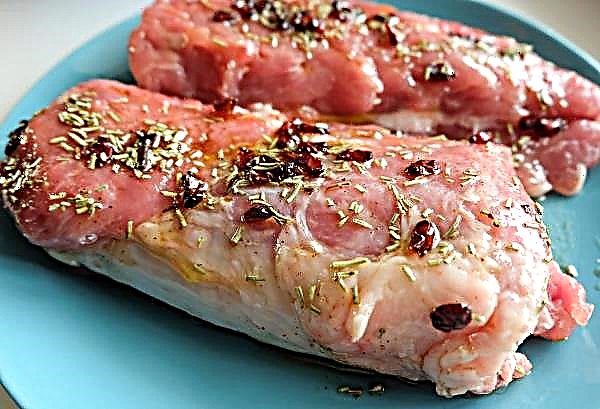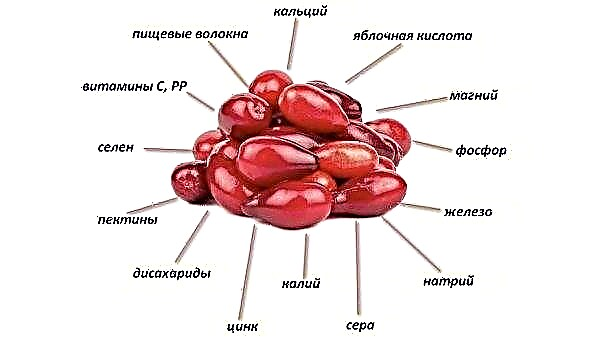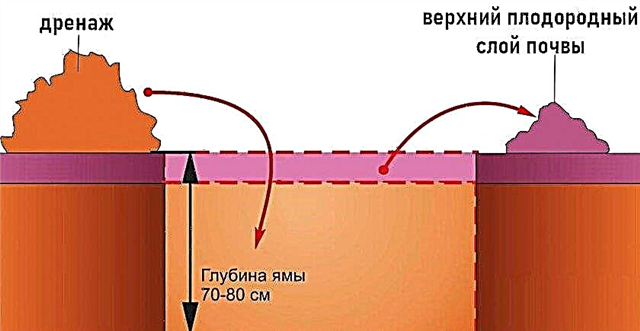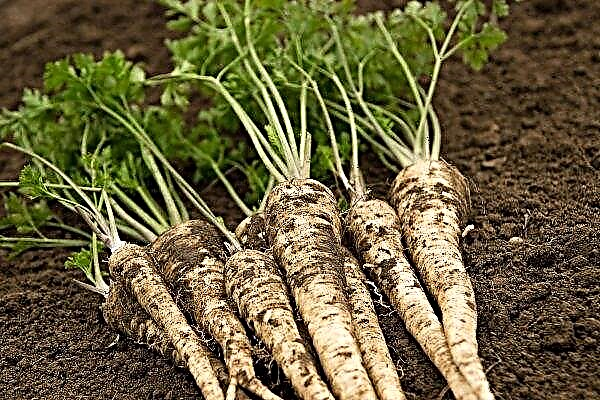Carrots are grown in many large and small-scale farms, but the yield of this crop can be significantly affected by the attack of harmful insects. One of the most common pests of carrots is a carrot fly, which infects fruits underground. This article provides a description and features of the life cycle of this insect, signs of its appearance on the beds, methods of control and the necessary preventive measures.
Description and characteristics of carrot flies
To successfully protect the beds from this pest, you need to study its description and features of the life cycle. An adult insect does not harm plantings, but is the cause of the appearance of larvae.
Did you know? At the ends of the legs of the flies are the organs of touch and taste, with the help of which insects sample food.
Characteristics of carrot flies are presented below:
- This diptera insect belongs to the family Psilidae, its body length is about 4.5 mm.
- The pest's chest and abdomen are painted black and covered with light fluff. The head is reddish-brown, and the legs are yellow.
- On the back of the insect there are two transparent wings of elongated shape with dark filamentous veins.
- Small oval pest eggs have a size of not more than 0.6 mm, are painted white. Light yellow larvae hatching from them, having a length of 5 mm and a shiny glossy torso.
- At the pupation stage, the larvae form around them a light brown cocoon, which is located in the upper soil layers at a depth of 15–25 cm.
- The peak activity of the pest falls in the morning and evening, when there is no strong heat and bright sun.

Pest Development Cycle
To prevent the appearance and spread of the pest in the garden, you need to know the time of the preventive and protective measures, as well as carefully examine the plants during the appearance of insects and their larvae.
Important! Insect productivity increases when there are nearby nectariferous plants that serve as a food source for the adult carrot fly.
The life cycle of a carrot fly is described below:
- Adult insects hatch from pupae in May, after the soil warms up to a temperature of + 15 ° С. From this moment begins the spring flight of the pest.
- The egg laying period lasts 20–25 days from the appearance of insects from pupae. Females lay eggs on the base of the carrot stem, so it is not easy to notice them.
- After 1–1.5 weeks, caterpillars emerge from the eggs, which penetrate the upper layers of the soil and feed on juicy root crops. They bite into carrots and live in it until pupation.
- The process of pupal formation occurs in the first half of July, and cocoons remain in the upper soil layers for 2–4 weeks.
- The second generation of adults is born in the time interval from the second half of July to early August. At this time, the summer flight of insects begins - they again lay eggs on the stems of plants, and the process repeats.
- When the time of pupation comes, the larvae from the second generation of carrot flies move to the upper layers of the soil and form a cocoon that can safely winter in the ground before spring.

Breeding methods
Among adult insects, there are individuals of male and female, therefore, reproduction is bisexual. Mass mating of insects occurs during the flowering season of chokeberry in May, after which the females begin to lay their eggs. One female can lay more than 100 eggs. If in this case the soil moisture drops below 60%, and the temperature on the soil surface exceeds + 20 ° C, then some of the eggs and caterpillars die.
Did you know? The average life span of a fly is about 30 days.
The causes and signs of a carrot fly on the site
Experienced gardeners have noticed that carrot flies love to breed in shaded areas with high soil moisture.
The main causes of this pest include:
- excessive watering of plants;
- thickening of landings;
- poor air circulation in the area;
- selection of a shaded area for beds;
- the presence in the soil of overwintered pupae of the pest.

There are several signs to notice the appearance of a carrot fly in the garden:
- the green tops of carrots acquire a purple-red color, and then turn yellow and dry;
- black passages made by caterpillars are noticeable on the root neck and in the pulp of the root crop;
- the fetus begins to rot from damage done by the tracks;
- the carrot affected by the larvae has an unpleasant odor, and its flesh becomes bitter and hard;
- the part of the root crop protruding from the soil turns purple.
How to deal with a carrot fly in the garden
When carrot flies appear on beds with plants, different control methods can be used. To understand how to save a carrot crop, you need to analyze all the methods of struggle and choose the most suitable. Sometimes you can get rid of carrot flies with the help of simple agricultural techniques, and with a small number of insects, folk remedies have a good effect. You can also use ready-made chemicals for pests, which are sold in specialized stores. About how to protect the beds from the invasion of these insects, later in the article.
Important! Fresh manure cannot be used to fertilize carrots - it increases the risk of the appearance of a carrot fly and creates a favorable atmosphere for the life of the larvae in the ground.
Agrotechnical method
You can get rid of carrot flies using agrotechnical methods, if you know the insect's weaknesses and use them correctly.
The main methods for eliminating the pest are listed below:
- deep digging in the autumn - this will allow to move pupae wintering in the ground closer to the surface, where they will die from low air temperature;
- growing carrots with onions - adult individuals are frightened off by the pungent smell of onions, therefore, with a mixed planting of these two cultures on the site, insects will fly around the beds side;
- planting marigolds and marigolds in the aisles of carrots - these flowers have a specific smell that repels the pest;
- a fence made of breathable material (tulle, spunbond) around the carrot plantings - its height should be at least 80 cm, since it is at such maximum height that a carrot fly can fly. A fence is placed around the perimeter of carrot beds, leaving on one side a closing passage for a person;
- thinning rows of carrots - eggs and larvae of a carrot fly die under the bright sun in dry soil;
- abundant watering of beds no more than 1 time in 5-7 days - will help to avoid excessive soil moisture and slow the active spread of carrot flies in the area;
- regular weeding and removal of weeds - will contribute to better soil warming by the sun;
- loosening the soil in the beds with the addition of mustard powder or red pepper - the smell of these spices effectively repels insects;
- mulching of beds with peat - the pest does not tolerate this component;
- removal from the site of affected plants - carrots gnawed by larvae are not suitable for winter storage, but they are a food source for larvae, which then spread to neighboring plants.
Important! Flies are often carriers of diseases dangerous to humans, such as cholera, polio, diphtheria, tuberculosis and typhoid fever.
The use of chemicals
Pest control with the help of chemicals (insecticides) gives the best result and can save the crop even with a large number of insects and larvae. But when using these products, you need to be careful, and also clearly follow the instructions on the packaging.
All chemical preparations against carrot flies can be divided into the following groups:
- Insecticides for preventive seed treatment before sowing - make plants resistant to pest attack. These include the drug "Prestige", in which the planting material is soaked before sowing.
- Chemicals that repel adult insects. They help prevent the appearance of larvae, thus preserving the entire crop of carrots, but are very poisonous. They remain in the soil and fruits for 30 days, retaining their toxic properties, and therefore can cause food poisoning. These drugs include Arrivo and Karate.
- Insecticides against carrot fly caterpillars. They contain diazinon, which adversely affects not only the caterpillars, but also the pupae. These preparations are intended for soil treatment in the fall and during the period of the appearance of caterpillars. These include Provotox and Bazudin.
Chemical spraying of beds is recommended in the morning or evening in dry weather, using personal protective equipment.
Important! The last treatment of carrots with insecticides should be carried out no later than 3 weeks before harvest, so that they have time to decompose into harmless components.
Folk methods of fighting a carrot fly
Experienced gardeners often use proven folk remedies to control pests. Unlike chemicals, they do not accumulate in fruits and soil, but also have a detrimental effect on caterpillars and insects.
The list of folk remedies for combating carrot flies is presented below:
- ammonia solution (2 tbsp. L. Per 10 l. Of water) - used to water carrots in spring and early summer, repelling insects with a persistent ammonia odor;
- saline solution (1 tbsp. Salt per 10 l of water) - in June, the beds are watered with this product twice, observing the interval of 10 days between treatments. Penetrating into the soil, saline has a detrimental effect on pupae and larvae of the carrot fly;
- onion husk infusion (400 g of husk per 5 l of boiling water) - the product is insisted for two days, and then filtered and used to spray carrots. The sharp aroma of the infusion discourages insects, and the husk used to prepare the solution can be decomposed between the rows;
- naphthalene tablets - they are placed in small plastic bottles with large openings and laid out between rows of plants. When heated in the sun, naphthalene emits a pungent odor that repels the pest;
- orange peel infusion (1 kg of orange peels per 10 liters of warm water) - this remedy is infused in a dark place for 3 days, and then used to irrigate carrots;
- broth from tomato tops (4 kg of leaves per bucket of boiling water) - the mixture is boiled for 30 minutes, and after cooling, add 50 ml of liquid soap and irrigate the plants with the obtained product. The smell of tomato tops repels insects, and liquid soap contributes to better adhesion of the infusion to the green mass of plants;
- tobacco dust - the powder repels the carrot fly with a pungent odor and is used to sprinkle row spacing;
- black or red pepper infusion (1 tbsp. Powder per bucket of water) - this tool is used to water carrots and adversely affects the pest larvae.
How to protect plants from carrot flies
You can prevent the appearance of carrot flies in the garden if timely preventive measures are taken.
The list of recommendations for protecting beds from pests is presented below:
- sowing carrots in late March, the second half of May or late autumn - in early plantings, the root crop has time to grow before the period of mass flight of insects, and May crops do not have time to form a fruit before laying eggs and the appearance of larvae;
- the choice of a well-lit area with light soil and good purge;
- crop rotation compliance - re-growing carrots in the same area is possible only after 2-3 years;
- the choice of carrot varieties resistant to attack by a pest - these include Flacco, Nantes 4, Perfection, Vitamin 5, etc .;
- soaking planting material in warm water (+ 40 ° C) for 2 hours;
- seed treatment of crops before sowing - for this, “Azotofit” or “Trichodermin” preparations are suitable.
 A carrot fly acts underground and can cause serious damage to the crop. But, knowing the features of the insect's life cycle and signs of plant damage, you can accurately determine the appearance of this pest in the area, and using the listed methods of control, you can accurately determine how to process carrots to eliminate the problem.
A carrot fly acts underground and can cause serious damage to the crop. But, knowing the features of the insect's life cycle and signs of plant damage, you can accurately determine the appearance of this pest in the area, and using the listed methods of control, you can accurately determine how to process carrots to eliminate the problem.





